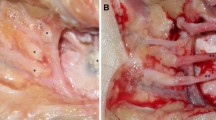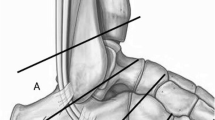Abstract
Background
The use of autologous nerve material has become the gold standard for reconstructing peripheral nerve defects. For various applications, nerve grafting is required to restore nerve continuity, and the sural nerve may be considered the best option for such purposes. The aim of this study was to quantitatively assess the recovery of donor site sensory deficit following sural nerve harvest.
Methods
This descriptive study was performed on 30 patients in the first week after surgery and 23 patients 1 year after sural nerve harvest. Mapping of the affected area was performed using Semmes–Weinstein monofilaments. Then, the areas of diminished or loss of sensation were evaluated with monofilament test, static and dynamic two-point discrimination, and temperature sensitivity. Also, the complaints of paresthesia, numbness, and pain were measured. The results were compared in the two groups.
Results
The area of diminished or loss of sensation 1 week after surgery was significantly reduced after 1 year (p = 0.000). A reduction was observed in the patients' complaints, especially in numbness and paresthesia, and better results were obtained in clinical findings, significantly in dynamic two-point discrimination and temperature sensation.
Conclusion
In this study, donor site adverse effects of sural nerve harvest decreased over time, and improvements in sensory tests were observed; however, more studies should be performed on this topic.
Level of Evidence: Level III, diagnostic study.


Similar content being viewed by others
References
Ray WZ, Mackinnon SE (2010) Management of nerve gaps: autografts, allografts, nerve transfers, and end-to-side neurorrhaphy. Exp Neurol 223(1):77–85
Fatemi MJ, Foroutan KS, Ashtiani AK, Mansoori MJ, Vaghardoost R, Pedram S, Hosseinpolli A, Rajabi F, Mousavi SJ (2010) Comparison of divided sciatic nerve growth within dermis, venous and nerve graft conduit in rat. J Res Med Sci 15(4):208–213
Yavuzer R, Yavuzer G, Ergin S, Latifoğlu O (2002) Gait analysis: a new perspective on sural nerve graft donor site morbidity assessment. Ann Plast Surg 48(4):449–450
Park HD, Kwak HH, Hu KS, Han SH, Fontaine C, Kim HJ (2007) Topographic and histologic characteristics of the sural nerve for use in nerve grafting. J Craniofac Surg 18(6):1434–1438
van Ouwerkerk WJ (1999) Endoscopy-assisted sural nerve harvest in infants. Childs Nerv Syst 15(4):192–195, Discussion, 196
Lapid O, Ho ES, Goia C, Clarke HM (2007) Evaluation of the sensory deficit after sural nerve harvesting in pediatric patients. Plast Reconstr Surg 119(2):670–674
Schubert HM, Wechselberger G, Hussl H, Schoeller T (2005) Peroneal nerve lesion after sural nerve graft harvest: an unusual complication–case report. Microsurgery 25(1):54–56
Lin CH, Mardini S, Levin SL, Lin YT, Yeh JT (2007) Endoscopically assisted sural nerve harvest for upper extremity posttraumatic nerve defects: an evaluation of functional outcomes. Plast Reconstr Surg 119(2):616–626
Miloro M, Stoner JA (2005) Subjective outcomes following sural nerve harvest. J Oral Maxillofac Surg 63(8):1150–1154
Martins RS, Barbosa RA, Siqueira MG, Soares MS, Heise CO, Foroni L, Teixeira (2012) Morbidity following sural nerve harvesting: a prospective study. Clin Neurol Neurosurg. doi:10.1016/j.clineuro.2012.02.045
Ehretsman RL, Novak CB, Mackinnon SE (1999) Subjective recovery of nerve graft donor site. Ann Plast Surg 43(6):606–612
Dros J, Wewerinke A, Bindels PJ, van Weert HC (2009) Accuracy of monofilament testingto diagnose peripheral neuropathy: a systemic review. Ann Fam Med 7(6):555–558
Booth J, Young MJ (2000) Differences in the performance of commercially available 10-g monofilaments. Diabetes Care 23(7):984–988
Collins S, Visscher P, De Vet HC, Zuurmond WW, Perez RS (2010) Reliability of the Semmes Weinstein monofilaments to measure coetaneous sensibility in the feet of healthy subjects. Disabil Rehabil 32(24):2019–2027
Birke JA, Brandsma JW, Schreuders TA, Piefer A (2000) Sensory testing with monofilaments in Hansen's disease and normal control subjects. Int J Lepr Other Mycobact Dis 68(3):291–298
Aszmann OC, Muse V, Dellon AL (1996) Evidence in support of collateral sprouting after sensory nerve resection. Ann Plast Surg 37(5):520–525
Conflict of interest
None
Author information
Authors and Affiliations
Corresponding author
Rights and permissions
About this article
Cite this article
Fatemi, M.J., Akbari, H., Taghavi, S. et al. Quantitative assessment of sural nerve donor site sensitivity: one week and one year after surgery. Eur J Plast Surg 36, 31–35 (2013). https://doi.org/10.1007/s00238-012-0741-z
Received:
Accepted:
Published:
Issue Date:
DOI: https://doi.org/10.1007/s00238-012-0741-z




